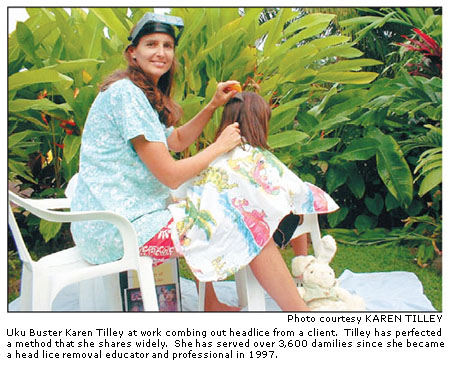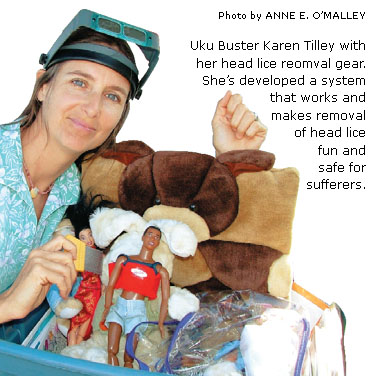| Kaua'i woman a world-class uku
'buster' Has brought relief to
3,600 families
By Anne O'Malley
Kaua'i Island News
January 28, 2005
 Millions
of people around the world suffer from infestations of head lice -- at
least 10 million children per year -- and both the prescribed and
over-the-counter remedies simply don't cut it, says a renowned expert.
Not only that, but those remedies, so easily available, may be extremely
harmful to the health of the user. Millions
of people around the world suffer from infestations of head lice -- at
least 10 million children per year -- and both the prescribed and
over-the-counter remedies simply don't cut it, says a renowned expert.
Not only that, but those remedies, so easily available, may be extremely
harmful to the health of the user.
So when get 'uku, who you
gonna call? UKUBUSTERS, that's who!
That would be Karen
Tilley of UKUBUSTERS Head Lice Removal and Education Service,
headquartered in Princeville. She's a world expert on the removal of
Pediculosis capitis, the wee misery causer about the size of a sesame seed
that needs blood sucked from the human scalp to cling to its adopted turf
-- symptoms are severe itching.
Tilley's been on TV and
she's been written about in numerous national and major metropolitan
publications in the U.S. and Canada. The reason she knows so much
about head lice is that she experienced it firsthand -- twice.
"I was a former chronic
long term sufferer in 1991 and again in 1996," says Tilley, a single
mother back then.
"Nothing I did worked to
remove them and I suffered extreme anguish. Since nothing worked,
the problem would not go away."
Tilley says it was like a
disease that she could not cure, the products she used simply didn't kill
the infestations. She felt shame and embarrassment that try as hard
as she might, she could not get rid of the lice, resorting to wearing a
hat in fear that she might give spread the infestation to others.
"Eventually, I discovered
the right equipment and safe method [of removal] through the Internet,"
she says.
She's brought relief to
over 3,600 families since then, relying on natural products and due
diligence. This respected expert gives consultations and treatments
and is educating the public about this communicable disease.
That's right,
communicable. How do lice spread?
"Head lice spread through
head to head contact from hair to hair," she says. "they do not jump
-- they do not have wings."
The business of no wings
is good news. The bad news is that there are still plenty of ways
for lice to spread.
That can happen by
sharing a comb or brush with someone that's infested, or sleeping with
that person. Children have few boundaries about body contact with
other children, and often you'll see them with their heads literally
together as they play.
Women get lice more
easily than men, usually from their lice-infested children, without even
knowing it, and in fact, 80- to 90 percent of mothers of infested children
will contract the head lice from their offspring.
"It's just the nature of
holding a child on the lap," says Tilley.
Tilley's misery set her
on a path that's led to more discoveries about lice and the treatment
often recommended by people who should know better.
On of the common
treatments of lice infestation is the pesticide Lindane. It was
contained in at least one formerly commonly prescribed head lice shampoo
called KWELL, a product that was pulled off the market.
There is now a generic
brand of shampoo that uses Lindane, is quite expensive, and is available
by prescription from a different pharmaceutical company.
California recognized the
problem with Lindane by 2000, when then-Governor Gray Davis signed into
law a bill that would prohibit any product from being used or sold in the
state if used for treatment of lice and scabies in human beings and
containing the pesticide Lindane.
The Los Angeles County
Sanitation District website explains with Lindane as follows:
"Lindane products, such
as shampoos and creams, are rinsed off after use into the public sewers.
Even after treatment, lindane persists and passes into creeks, rivers,
lakes and oceans.
"Lindane is toxic in the
water even in very small amounts. In fact, a single treatment of
head lice or scabies with lindane pollutes 6 million gallons of water, the
equivalent of 300 swimming pools.
"Lindane lasts for a long
time in the environment, where it can contaminate the tissues of fish and
other animals. The United States Environmental Protection Agency has
declared lindane to be a persistent bioaccumulative, and toxic chemical."
 The
best method -- and it seems the most effective one -- is totally natural
says Tilley, who teaches the importance of removing every last nit and
louse from the hair. This is key to curing head lice, she says --
not pesticidal application. The
best method -- and it seems the most effective one -- is totally natural
says Tilley, who teaches the importance of removing every last nit and
louse from the hair. This is key to curing head lice, she says --
not pesticidal application.
Her process involves wet
nit combing and then nitpicking. She provides professional grade
head lice removal equipment, a guide she's written called "The Karen
Tilley Program of Head Lice Removal" and phone consultations.
Testimonials flow from
grateful clients such as Donna Farley, a certified nurse-midwife who sent
her a note after dealing with a chronic head lice infestation on of her
children had.
"Karen," wrote Farley,
"you are the 'Uku Fairy! Thank you so much.
"I had tried everything
suggested and nothing worked. It wasn't until you came and 'did your
thing' that we were cured."
Although she protects
herself while serving clients, occasionally Tilley may get infected.
"I cure myself in two
hours instead of six months of constant struggle," she says. "This
is what parents learn from me to help them.
Tilley says she loves her
work, of helping children and their mothers remove a terrible nightmare
from their lives. She feels its important to spread the word about
Lindane, for parents to discontinue using head lice pesticides.
"It might sound funny,
too, but my favorite clients are the people that've had it the longest.
"I feel like I'm a ghost
buster. I feel like I put the siren on and I'm off on a mission to
bust the bugs."
Tilley offers two types
of lice removal kits, consulting, hands-on delousing and her book.
She may be reached at 808-335-LICE. Her website is
www.ukubusters.com. |